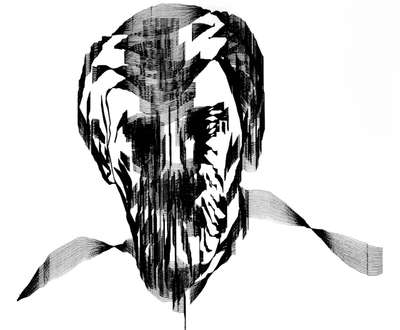One of the most famous pieces of early computer art. By the time of its creation, Charles Csuri was collaborating with programmer James Shaffer at Ohio State University, Columbus, Ohio.
The work was awarded first prize at the 1967 Computer Art Contest, offered by the magazine Computers and Automation.
In 1967, the work stood out as one of the most complex figurative computer-generated images. Csuri and Shaffer explain their procedure thus:
“A picture of a man was placed in the memory of an IBM 7094. Mathematical strategies were then applied to the original data. The X value remained constant, and a sine curve function was placed upon the Y value. Given the X and Y coordinates for each point, the figure was plotted from
X’ = X, Y’ = Y + C * SIN (X) where C is increased for each succesive image.” [Csuri, 1967], [cf. Csuri and Shaffer, 1968]
In, perhaps, simpler terms, this is what is happening on the computer. A line drawing (of an old man) is transformed repeatedly, and each of the transformed line drawings is executed. Each of the transformations vertically shifts a point (X, Y) of the given curve. The distance of the point’s move up or down from its given position is determined by the sin function (as the formula indicates). For each of the repeated curves, the constant factor C is changed a little.
The intriguing effect created by this mathematical transformation is responsible for the astonishing reactions of people when they saw the work. Some may have been reminded of a technique Robert Rauschenberg was using occasionally.
See also Sine Curve Man (1968) und (1969).







